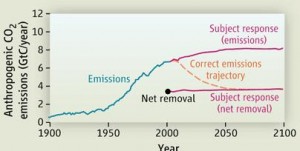An interesting piece in Science this week titled Risk Communication on Climate: Mental Models and Mass Balance illustrates the difficulties in understanding the impact of climate change and the effects emissions mitigation efforts could have.
In a recent experiment at Massachusetts Institute of Technology (MIT), 212 graduate students were given an explanation of the relationship between greenhouse gas emissions, atmospheric concentrations of CO2 and global mean temperature.
The students were then asked to sketch on a graph the “emissions trajectory” required to stabilise atmospheric CO2. The results were illuminating.

As John D. Sterman, the author of the Science piece points out: “84% drew patterns that violated the principles of accumulation. If emissions followed the path in the typical example shown, atmospheric CO2 would continue to rise.
“Nearly two-thirds of the participants asserted that atmospheric GHGs can stabilize even though emissions continuously exceed removal–analogous to arguing a bathtub continuously filled faster than it drains will never overflow. Most believe that stopping the growth of emissions stops the growth of GHG concentrations. The erroneous belief that stabilizing emissions would quickly stabilize the climate supports wait-and-see policies but violates basic laws of physics.”
These were grad students with degrees in science, technology, engineering, mathematics and economics, yet most of them made fundamental flaws in estimating the required action needed to stabilise CO2 emissions.
So how then is the public expected to get its head around the issue? As Sterman shows, this is a real problem. Until there is widespread understanding of the issue and the required path of action, there won’t be the buy-in to make it happen. In simpler terms, understanding among the public = interest from politicians = action on climate change.
Says Sterman: “…reducing GHG emissions requires billions of individuals to cut their carbon footprints by, e.g., buying efficient vehicles, insulating their homes, using public transit, and, crucially, supporting legislation implementing emissions abatement policies.
“Changes in people’s views and votes create the political support elected leaders require to act on the science. Changes in buying behaviour create incentives for businesses to transform their products and operations. The public cannot be ignored.”